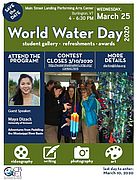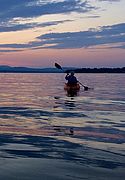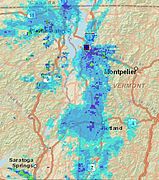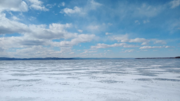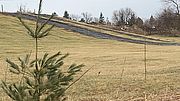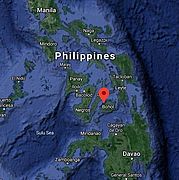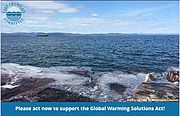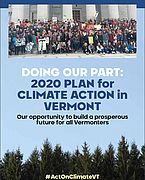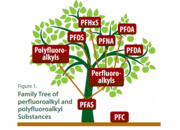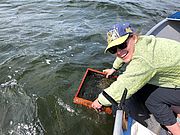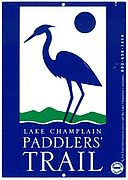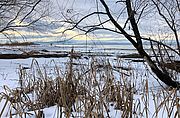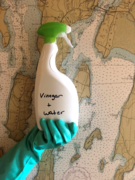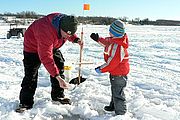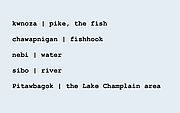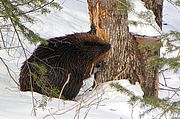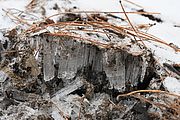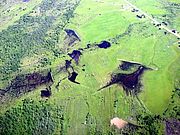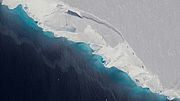Know a K through 12 student, teacher or homeschooler in the Lake Champlain Basin? In honor of World Water Day, LCC and Champlain Basin Education Initiative (CBEI) partners are hosting our annual cool contest to celebrate water. It’s a great way for educators to integrate art and science with their students.
Read...News from Selected Month
LCC seeks boating pictures to enhance our 2020 edition of the Paddlers’ Trail guidebook. If you ventured out on the water with a camera, please consider sharing some photos with us. We are looking for images of human-powered adventures on Lake Champlain and any discoveries made along the way. Scenes of paddling with friends (all wearing PFDs of course), packing your gear, fishing from your boat, and other visual reflections of water outings are welcome.
Read...If your faucet drips or your toilet runs it can waste over 10,000 gallons a year ― the amount of water in a typical backyard swimming pool. More than one trillion gallons of water are lost annually in the U.S. due to easy-to-fix household leaks.
Read...While the sun shines on Montpelier, it could be dumping snow 50 miles southwest in Cornwall, VT. Apart from major snowstorms, namely Nor’easters and “Alberta Clippers,” the formation of lake-effect snow over Lake Champlain is one of the many weather patterns that turns the Champlain Valley into a winter wonderland. Lake-effect snows occur under conditions where the presence of a lake is required.
Read...On the beaches of Lake Champlain and in the branches of shoreline vegetation plastic bags flap in the breeze. These conspicuous “flags” are one of the many forms of plastic water pollution. Images of a plastic straw jammed up the nostril of a sea turtle, plastic bottles suspended in the Great Pacific Garbage Patch, and plastic-packed guts of fish and birds appear in our news feeds.
Read...If you look at items kept in basements, under sinks, and in the dark recesses of the garage, the odds are good that some of them contain harmful ingredients. How do you know if they’re hazardous? Words and symbols for “Warning,” “Danger,” and “Caution” are often readily visible. Household items that are corrosive, ignitable, poisonous, reactive, or toxic are known as Household Hazardous Waste (HHW).
Read...The freeze over of Lake Champlain is a celebrated event. Due to warming winter temperatures, the lake does not ice over as often as it did 20 years ago, making this phenomenon special. Though the lake froze over last year (closure date of March 8), as well as in 2014 and 2015, chances are Lake Champlain will not freeze over in 2020.
Read...The plastic bag ban in New York State begins Sunday, March 1, 2020! Whether floating on a local waterway or stuck in a tree, plastic bags are a too common sight and blight on the landscape and in the water. Do your part to reduce plastic pollution and bring your own bag from the start.
Read...The Lake Champlain Committee (LCC) is no stranger to defending Vermont’s clean water laws. In December 2019, LCC was part of a coalition of environmental organizations that issued a press release on the unlawful emergency exemptions for farm manure spreading that result in pollution discharges into nearby waters.
Read...Arctic char, closely related to lake and brook trout, are a relic of the last Ice Age. When glaciers in New England receded between 10,000 and 12,000 years ago, the char colonized areas of inland New England. Other than Alaska, Maine is the only state with native Arctic char populations. This species occupies an array of aquatic habitats, from open oceans to inland rivers, throughout its geographic range.
Read...Photosynthetic bacteria, gelatin, and concrete are the building blocks of a new type of material: living concrete! Researchers at the University of Colorado, Boulder, funded by the Department of Defense, formed the new substance. Minerals in the concrete are deposited by cyanobacteria; in contrast to the typical greenhouse gas-emitting process required in the production of regular concrete, cyanobacteria absorb carbon dioxide through the photosynthetic process.
Read...As the seas rise higher, low lying islands and coastal areas are continually threatened by floods. Batasan, an island in the Philippines, is no exception. In 2013, a major earthquake (7.2 magnitude) hit the island, causing it to collapse downward.
Read...The Vermont Global Warming Solutions Act (GWSA - H.688) will be on the House floor tomorrow, February 20 for a crucial vote. The bill sets binding targets and holds the state accountable to develop and implement a plan to meet Vermont’s commitment to the Paris Climate Accord by 2025 and achieve net-zero carbon emissions by 2050.
Read...Recognizing that climate change poses an existential threat to Lake Champlain water quality, LCC was among 30 diverse organizations to present a policy plan of action to Vermont leaders in January. Since 2006, the state has had statutory goals to cut carbon pollution but we are very far from meeting them. Vermont is falling behind its Northeast neighbors in making pollution reductions, in part because the state lacks requirements to do so.
Read...Earlier this month Jared Carpenter, LCC’s Water Protection Advocate, joined with colleagues from the Vermont Conservation Voters, Vermont Natural Resource Council and other organizations to present the 2020 Environmental Common Agenda. The Common Agenda represents priorities of environmental groups across Vermont who are working to engage policy makers and citizens on important issues that affect water, air, land, wildlife, communities and health.
Read...In July 2019, LCC welcomed Lauren Sopher to the staff as our Director of Science and Water Programs. Lauren grew up in Vermont traipsing after frogs and toads along Monroe Brook, paddling the LaPlatte River, and exploring Lake Champlain’s surface and shorelines.
Read...A grant from outdoor gear co-op REI will enable LCC to purchase signage for Lake Champlain Paddlers’ Trail sites, update website content, and produce informational materials about the Trail. The funds will also cover a touring kayak and related gear for LCC field programs. “This REI grant will help us publicize the Trail, re-sign locations and upgrade our equipment,” notes LCC Executive Director Lori Fisher. “We’re grateful for the support to advance our stewardship.” REI will also be partnering with LCC on April Stools’ Day and aquatic invasive species assessments.
Read...Lakeshore and grassland are like yin and yang: seemingly opposite forces that are complimentary. The lakeshore provides water disturbance to the grass and the grassland provides shoreline stabilization to the lake—both processes shape this natural system.
Read...Every space gets dirty. Whether at home, at work, or somewhere in between, most of us use cleaning products on a regular basis to tidy up. While commercial products may get things squeaky clean, they can also do more harm than good. Many contain ingredients that can be acutely toxic; carcinogenic or mutagenic; irritating to skin, eyes or lungs; non-biodegradable; poisonous to aquatic organisms; or water and air polluting. Some common components of store bought cleaners to watch out for include ammonium, formaldehyde, glycol ethers, sodium borate, sodium laureth sulfates along with artificial colors, dyes and fragrances.
Read...Plant identification is not restricted to a particular season. Though woody plants can be difficult to identify in winter, the activity adds a new dynamic to winter adventures and is a fun challenge. Read on for identification tips about two common wetland shrub species, speckled alder (Alnus incana) and red-osier dogwood (Swida sericea), along with their value and role in wetland ecology.
Read...There is great potential behind a hole in the ice. On Lake Champlain, those holes are often related to ice fishing. You can make ice fishing what you want it to be: a social or solo activity, over a short or long timespan, and on open ice or under the cover of a shanty. No matter the approach, it’s an activity that gets folks outside and interacting with the natural world in the wintertime.
Read...In partnership with Jesse Bowman Bruchac, a Nulhegan Abenaki citizen and a teacher of the Abenaki language, the Middlebury Language Schools is launching a pilot School of Abenaki in summer 2020. Native to New England and Quebec, the Abenaki language is considered endangered.
Read...Beavers are active year-round. Explore what a beaver lodge and dam is like in the wintertime with conservation biologist, Steve Faccio, and Outdoor Radio co-hosts, Kent McFarland and Sarah Zahendra, at a frozen beaver pond in Pomfret, VT. From huddling together in lodges to storing their winter stash of food in the snow, you’ll learn about how North America’s largest rodent faces winter.
Read...Ice formations are a wonderful display of winter. Temperature gradients impact the formation and type of ice we observe. Water at or near the soil surface freezes and expands into the open space above ground, creating spectacular columns of ice, reminiscent of crystal chandeliers.
Read...The Trump Administration recently finalized a rule that removes protections on waterbodies across the country. Trump’s new rule, “Navigable Waters Protection Rule,” rolls back crucial components of the Obama administration’s 2015 rule, “Waters of the United States” and the 1972 Clean Water Act.
Read...Scientists studying Antartica’s Thwaites Glacier, larger in size than the state of Pennsylvania, are concerned about rising water temperatures at its “grounding line.” The grounding line is where the glacier transitions from laying on bedrock to floating on the ocean as ice shelves.
Read...
